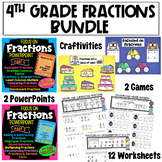4th Grade Fractions PowerPoint Bundle
- Zip
- Google Apps™

What educators are saying
Products in this Bundle (2)
Also included in
- This fraction activity bundle focuses on the fraction skills identified in the 4th grade Common Core math standards. It includes two PowerPoints, exit tickets, twelve worksheets, two craftivities, and two Concentration Games.1. Fourth Grade Fractions: Part 1: These resources focus on the first portiPrice $18.00Original Price $27.75Save $9.75
Description
This bundle of two fraction PowerPoints focuses on the fraction skills identified in the 4th grade Common Core math standards. It features MANY practice opportunities!
These are the topics covered in Fourth Grade Fractions: Part 1 (49 slides)
→ Equivalent Fractions
→ Simplifying Fractions (and Least Common Multiple)
→ Comparing Fractions (and Greatest Common Factor)
→ Benchmark Fractions
These are the topics covered in Fourth Grade Fractions: Part 2 (75 slides)
→ Adding and Subtracting Fractions
→ Adding and Subtracting Mixed Numbers
→ Decomposing Fractions
→ Multiplying Fractions (this section includes slides on improper fractions and converting them to mixed numbers)
→ Decimals and Fractions- Conversions, Adding, & Comparing
Each section contains MANY practice opportunities!
This PowerPoint contains TWO EXTRA BONUS FEATURES!!
- A PowerPoint companion handout is included in this file. As you advance through each PowerPoint, students can record their answers on the handout. The companion handout is available in both printable format or digital format. The digital version is compatible with Google Slides.
- After each section of the PowerPoints, hand out a half-sheet exit slip and have students complete it independently. When you correct the exit slips, you are presented with immediate feedback on which students might need additional small group or individual instruction. The exit tickets are available in both printable format or digital format, as well.
CHECK OUT THE PREVIEWS!
Here's what teachers like you have to say about using this fractions PowerPoint bundle with their students:
⭐️ Cassandra C. said, "This was an amazing resource for teaching and practicing fractions. The way it was explained and broken down helped introduce the skill then it had the companions for them to fill out as we did it together. Lastly, it had the exit ticket for them to complete so I was able to see if they understood the material. It was interactive and engaging for them."
⭐️ Ashley H. said, "Absolutely love your PowerPoints. It saves me so much time to have these and I love the transitions. Very engaging for students."
⭐️ Beth C. said, "These PPTs are awesome. They give a simple lesson and then tons of practice in each concept. The companion sheet allows students to practice while creating notes."
⭐️ Tracey L. said, "I love the way these PowerPoints are organized. I am using them in my mini-lessons."
Please note: You DO have my permission to convert this PowerPoint to Google Slides, and to share it with your students via Google Classroom. (A Google link is not provided, but you may upload the PowerPoint to Google yourself, if you wish.)
Also, these PowerPoints cannot be edited due to the copyright requirements made by the contributing artists (clip art, font, background).
Copyright by Deb Hanson
This item is a paid digital download from my TpT store
www.teacherspayteachers.com/Store/Deb-Hanson
This product is to be used by the original downloader only. Copying for more than one teacher is prohibited. This item is also bound by copyright laws. Redistributing, editing, selling, or posting this item (or any part thereof) on an Internet site that is not password protected are all strictly prohibited without first gaining permission from the author. Violations are subject to the penalties of the Digital Millennium Copyright Act. Please contact me if you wish to be granted special permissions!






